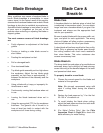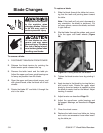
G0640X 17" Wood/Metal Bandsaw
-27-
Blade Terminology
Selecting the right blade for the cut requires a
knowledge of various blade characteristics.
Blade Terminology
A. Kerf: The amount of material removed by the
blade during cutting.
B. Tooth Set: The amount each tooth is bent
left or right from the blade.
C. Gauge: The thickness of the blade.
D. Blade Width: The widest point of the blade
measured from the tip of the tooth to the back
edge of the blade.
E. Tooth Rake: The angle of the tooth from a
line perpendicular to the length of the blade.
F. Gullet Depth: The distance from the tooth tip
to the bottom of the curved area (gullet).
G. Tooth Pitch: The distance between tooth
tips.
H. Blade Back: The distance between the bot
-
tom of the gullet and the back edge of the
blade.
I. TPI: The number of teeth per inch measured
from gullet to gullet.
blade selection
Figure 36. Bandsaw blade terminology.
G
B
C
D E F H
I
A
Selecting the right blade for the cut requires a
knowledge of various blade characteristics. If you
will be cutting metal, refer to Page 37 for addi
-
tional considerations
.
Blade Length
Measured by the circumference of the band,
blade length varies by saw.
Model Blade Length
G0640X ..................................................... 131
1
⁄2"
Blade Width
Measured from the back of the blade to the tip of
the blade tooth (the widest point), blade width is
often the first consideration given to blade selec
-
tion. Blade width dictates the largest and smallest
curve that can be cut, as well as how accurately
it can cut a straight line—generally the wider the
blade, the straighter it will cut.
Model Blade Width Range
G0640X ......................................................
1
⁄8"–1"
• Curve Cutting: Determine the smallest radi-
us curve that will be cut on your workpiece
and use the list below to select the correct
blade width.
Blade Selection
Blade Width Radius
1
⁄8" ....................................
1
⁄8"
3
⁄16" ...................................
3
⁄8"
1
⁄4'' ....................................
5
⁄8''
3
⁄8'' ....................................1
1
⁄4''
1
⁄2'' ....................................2
1
⁄2''
5
⁄8'' ....................................3
3
⁄4''
3
⁄4'' ....................................5
1
⁄2''
• Straight Cutting: Use the largest width
blade that you own. Narrow blades can cut
tight curves (a small radius) but are not very
good at cutting straight lines because they
naturally wander (blade lead). Wide blades
excel at cutting straight lines and are less
prone to wander.


















